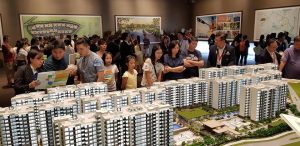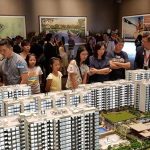Leonard Tay, Head of Research, Knight Frank Singapore, writing a commentary said homebuyers adapt during the Circuit Breaker conclude deals
- Mr Tay noted that a quick count of real estate caveats in the private residential sector from 7 April to 1 June 2020 during the circuit breaker, showed that there were 967 caveats. Of this total, 577 were new sales, while 380 were resale transactions and the remaining 10 sub sales. As meager as the numbers may seem, it is possible to sell and purchase private homes, despite the restrictions.
- Mr tay added that the sales volume of new homes dominated private residential transactions in May, notwithstanding the closure of showflats during that period, counter intuitive to conventional sense. With some 484 new sale caveats, this exceeded April’s total new sales of 267 caveats by 81.3%.
Singapore implemented the circuit breaker from 7 April 2020 to 1 June 2020 to stem the spread of COVID-19 infections in the community. The circuit breaker imposed stringent measures on work activities and human movement, making it challenging for real estate transactions to materialise.
As usual, new homebuyers adapt to this new situation and turned to their computers and devices in May to conclude deals, despite the circuit breaker and showflats being closed, said Mr Tay.
Table of Contents
A Stocktake on how the Private Residential Market Fared during the Circuit Breaker and How Quickly Homebuyers Adapt
Despite the restrictions on physical interaction, there is life yet for the real estate market. From 7 April to 1 June 2020 during the circuit breaker, there were 967 caveats in the private residential sector. Of this total, 577 were new sales, while 380 were resale transactions and the remaining 10 sub sales.
|
NUMBER OF PRIVATE RESIDENTIAL CAVEATS |
||||
|
Property Sector |
New Sale |
Sub Sale |
Resale |
Total |
|
January 2020 |
541 |
22 |
698 |
1,261 |
|
February 2020 |
916 |
10 |
597 |
1,523 |
|
March 2020 |
628 |
10 |
740 |
1,378 |
|
Total for Q1 2020
|
2,085
|
42
|
2,035
|
4,162
|
|
Week before Circuit Breaker (1 – 6 April 2020) |
174 |
– |
129 |
303 |
|
1st Month of Circuit Breaker (7 – 30 April 2020) |
93 |
5 |
226 |
324 |
|
2nd and Full Month of Circuit Breaker (1 May to 1 June 2020) |
484 |
5 |
154 |
643 |
|
Total (7 April to 1 June 2020) |
577 |
10 |
380 |
967 |
Source: URA Realis, based on caveats available on 9 June 2020
Overall monthly demand was down during April and May compared to the first quarter of 2020, which accounted for a total of 4,162 caveats, or an estimated monthly average of 1,387 caveats. It seemed that when Singapore entered the circuit breaker in April, the worst was to be expected with 324 caveats during the three weeks from 7 April to 30 April. Combined with the 303 caveats in the first week of April, this amounted to a total of 627 transactions during the month. However in May, when the entire month was under the restrictions of the circuit breaker, there were 643 caveats. A slight 2.6% improvement over April.
The new home sales volume that dominated private residential transactions in May, notwithstanding the closure of showflats during that period, is somewhat counter-intuitive to conventional sense. With some 484 new sale caveats, this exceeded April’s total new sales of 267 caveats by 81.3%. It could be that many of these new home buyers who sealed the deal in May had already been to the showflats prior to the circuit breaker, and weeks thereafter of staying at home helped in some measure towards a decision-making purchase.
Mr Tay noted that homebuyers adapt quickly and it could be that other buyers were confident enough to make a purchase with only the aid of online visuals and information.
“Regardless of the reasons, homebuyers have exhibited a degree of adjustment and adaptation to the prevailing circumstances, in a time of COVID-19.”
Data released by the Urban Redevelopment Authority (URA) of Singapore on Friday, 15 June, showed that 486 new private homes, excluding Executive Condominiums (ECs) were sold in May, up by 75.5% from the 277 units that were shifted in April 2020. On a year-on-year (YOY) basis, developers’ sales declined 48.9% from the 952 units (excl. ECs) transacted in May 2019.
Despite a full month of circuit breaker measures and the absence of physical showflat viewings, homebuyers adapt quickly as May developers’ sales jumped 75.5% month-on-month (MOM), albeit from a very low base in April, as buyers weigh discounts dangled and lower borrowing costs amidst virtual viewings and online research.
This brings the May developers’ sales of private homes (excluding ECs) to 2,912 units in year-to-May, 17.4% lower than the 3,527 units in year-to-May 2019.

May developers’ sales saw 23 ECs being sold – which are a hybrid of public and private housing – also higher than the 16 ECs sold in April. This brings total developer sales (including ECs) in May to 509 units, up 73.7% MOM and down 46.5% YOY.
With the circuit breaker still in force during the entire month of May, developers did not launch any new projects – the sales came entirely from earlier-launched projects, with which buyers could be familiar after having visited their showflats earlier, or which have registered sufficient sales to inspire confidence.
Ms Tricia Song, Head of Research for Singapore at Colliers International said, “The best-selling private residential projects in May were: Treasure at Tampines which moved 56 units at a median price of S$,360 psf; Parc Clematis which sold 55 units at a median price of S$1,599 psf and The Florence Residences which moved 54 units at a median price of S$1,513 psf.”
Mr Desmond Sim, Head of Research, Southeast Asia, CBRE, noted: “To date, new home sales figures from Jan to May 2020 totalled at 2,912 units, representing a decline of 17.4% y-o-y. Taking into account that economic uncertainty is likely to worsen in H2 2020, CBRE Research maintains that new home sales volume forecast is expected to fall between 4,000 and 5,000 units (excluding ECs) for the whole of 2020.”
Mr Paul Ho, chief mortgage officer at iCompareLoan, noting how quickly homebuyers adapt said: “the month-on-month increase is indeed surprising, but developers have been dangling many “carrots” for buyers, and some buyers may have thought that this is the best time to buy.”






